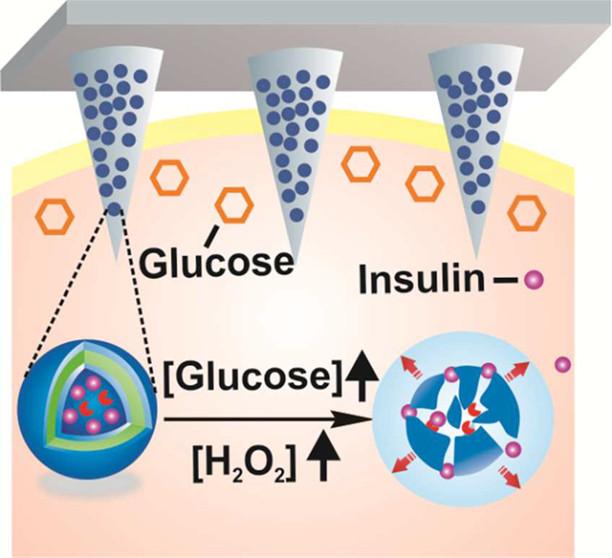
Toward a 'smart' patch that automatically delivers insulin when needed

Tiny, painless microneedles on a patch can deliver insulin in response to rising glucose levels.
Credit: American Chemical Society
People with Type 1 diabetes don't make insulin — a hormone that regulates blood glucose, or sugar. Those with Type 2 diabetes can't use insulin effectively. Either way, glucose builds up in the blood, which can lead to a host of health problems, including heart disease, stroke, blindness and amputation of toes, feet or legs.
To avoid these outcomes, people with Type 1 or advanced Type 2 diabetes regularly prick their fingers to measure blood-sugar levels, and some patients must inject themselves with insulin when needed.
But sometimes, despite a person's vigilance, glucose levels can still get out of whack. Zhen Gu and colleagues wanted to come up with a simpler, more effective, shot-free way to manage diabetes.
The researchers developed a skin patch covered in painless microneedles that are loaded with tiny insulin-carrying pouches. The pouches are engineered to break apart rapidly and release the insulin in response to rising glucose levels.
Diabetic mice wearing the patch maintained consistent concentrations of insulin in their blood. When these mice received a shot of glucose, their blood sugar levels spiked initially, but then fell to normal levels within two hours.
###
The authors acknowledge funding from the American Diabetes Association, National Institutes of Health and the National Science Foundation.
The abstract that accompanies this study is available here.
The American Chemical Society is a nonprofit organization chartered by the U.S. Congress. With nearly 157,000 members, ACS is the world's largest scientific society and a global leader in providing access to chemistry-related research through its multiple databases, peer-reviewed journals and scientific conferences. ACS does not conduct research, but publishes and publicizes peer-reviewed scientific studies. Its main offices are in Washington, D.C., and Columbus, Ohio.
To automatically receive news releases from the American Chemical Society, contact newsroom@acs.org.












